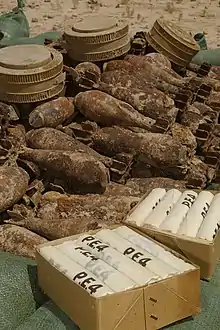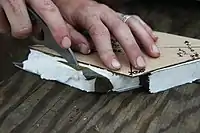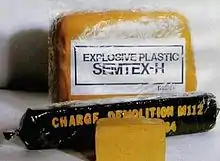Plastic explosive
Plastic explosive is a soft and hand-moldable solid form of explosive material. Within the field of explosives engineering, plastic explosives are also known as putty explosives[1] or blastics.
.jpg.webp)
Plastic explosives are especially suited for explosive demolition. Common plastic explosives include Semtex and C-4. The first manufactured plastic explosive was gelignite in 1875, invented by Alfred Nobel.
Usage

Plastic explosives are especially suited for explosive demolition of obstacles and fortifications by engineers, combat engineers and criminals as they can be easily formed into the best shapes for cutting structural members and have a high enough velocity of detonation and density for metal cutting work.
An early use of plastic explosives was in the warhead of the Petard demolition mortar of the British Armoured Vehicle Royal Engineers (AVRE) which was used to destroy concrete fortifications encountered during Operation Overlord (D-Day). The original use of Nobel 808 supplied by the SOE was for sabotage of German installations and railways in Occupied Europe.
They are generally not used for ordinary blasting as they tend to be significantly more expensive than other materials that perform just as well in this. A common commercial use of plastic explosives is for shock hardening high manganese percentage steel, a material typically used for train rail components and earth digging implements.[2]
Reactive armor in tanks uses plastic explosives sandwiched between two plates of steel. Incoming high explosive shaped charge anti-tank rounds pierce the outer steel plate, then detonate the plastic explosive. This disrupts the energy from the incoming round and shields the tank.[3]: 9
History

The first plastic explosive was gelignite, invented by Alfred Nobel in 1875.[4] Prior to World War I, the British explosives chemist Oswald Silberrad obtained British and U.S. patents for a series of plastic explosives called "Nitrols", composed of nitrated aromatics, collodion, and oxidising inorganic salts. The language of the patents indicate that at this time, Silberrad saw no need to explain to "those versed in the art" either what he meant by plasticity or why it may be advantageous, as he only explains why his plastic explosive is superior to others of that type.[5]
One of the simplest plastic explosives was Nobel's Explosive No. 808, also known as Nobel 808 (often just called Explosive 808 in the British Armed Forces during the Second World War), developed by the British company Nobel Chemicals Ltd well before World War II. It had the appearance of green plasticine with a distinctive smell of almonds. During World War II it was extensively used by the British Special Operations Executive (SOE) at Aston House for sabotage missions.[6] It is also the explosive used in HESH anti-tank shells and was an essential factor in the devising of the Gammon grenade. Captured SOE-supplied Nobel 808 was the explosive used in the failed 20 July plot assassination attempt on Adolf Hitler in 1944.[7]
During and after World War II a number of new RDX-based explosives were developed, including Compositions C, C2, and eventually C3. Together with RDX, these incorporate various plasticizers to decrease sensitivity and make the composition plastic. The origin of the obsolete term "plastique" dates back to the Nobel 808 explosive introduced to the U.S. by the British in 1940. The samples of explosive brought to the U.S. by the Tizard Mission had already been packaged by the SOE ready for dropping via parachute container to the French Resistance and were therefore labeled in French, as Explosif Plastique. It is still referred to by this name in France and also by some Americans.
Types
Composition C
The British used a plastic explosive during World War II as a demolition charge. The specific explosive, Composition C, was 88.3% RDX and 11.7% non-oily, non-explosive plasticizer.[8] The material was plastic between 0 and 40 °C (32–104 °F), but was brittle at colder temperatures and gummy at higher temperatures. Composition C was superseded by Composition C2, which used a mixture of 80% RDX and 20% plasticizer. Composition C2 had a wider temperature range at which it remained plastic, from −30 to 52 °C (−22 to 126 °F). Composition C2 was replaced by Composition C3, which was a mixture of 77% RDX and 23% explosive plasticizer.[9]: 8–109 C3 was effective but proved to be too brittle in cold weather and was replaced with C4. There are three classes of C4, with varying amounts of RDX and polyisobutylene.[9]: 8–111
List of plastic explosives
- Australia: PE4,[10][11] PE4-MC[12]
- Austria: KNAUERIT SPEZIAL
- Czech Republic: Semtex-1H (orange-colored), Semtex 1A (red-colored), Semtex 10 (also called Pl Np 10; black-colored), Pl Hx 30 (gray-colored)
- Finland: PENO
- France: Hexomax,[13][14] Composition C-4[15] PLASTRITE (FORMEX P1, Pla Np 87)
- Germany: Sprengkörper DM12, P8301, Seismoplast 1 (Sprengmasse, formbar)
- Netherlands: Knaverit S1 (light orange-colored)
- Greece: C3, C4
- India: PEK-1[16]
- Israel: Semtex
- Italy: T-4 Plastico
- Norway: NM91 (HMX), C4, DPX10 (PE8)
- Pakistan: PE-3A[17]
- Poland: PMW, NITROLIT
- Russia: PVV-5A Plastic Explosive
- Slovakia: CHEMEX (Composition C-4 equivalent), TVAREX 4A, Pl Hx 30
- South Africa: PE9 (Composition C-4 equivalent)[18]
- Spain: PG2,PG4, GOMA 0, GOMA 1, GOMA 2
- Sweden: Sprängdeg m/46, NSP711 (PETN-based), NSH711 (cyclonite-based)
- Switzerland: PLASTEX produced by SSE[19]
- Turkey: Composition C-4[20][21]
- United Kingdom
- MOD explosives: PE2 (sheet explosive, superseded by SX2),[22] PE3A (superseded by PE4),[23] PE4 (pure to off-white slab, block, or stick, superseded by PE7 and PE8 in MOD usage),[24][23][25][26][27][28][29][13] SX2 (sheet explosive, superseded by SX4),[24][25][30][31] PE7 (pure to off-white slab or block, Hexomax variant),[13][14] PE8 (pure to off-white slab or block, current in-service slab charge),[32][33][34] SX4 (sheet explosive),[35] DPX (DPX1 used in L26A1 Bangalore Torpedo Demolition Charge, DPX9 used in SABREX and as a key component of SX4)[36][37][38][35]
- Non-MOD explosives: Composition C-4 (M5A1 and M112 charges produced by Mondial Defence Systems),[39] Semtex (Several variants including Razor produced by Mondial Defence Systems, PW4 variant produced by Chemring)[40])[41][42][43]
- USA: Composition C-4 (pure white block or sheet, current in-service charges designated as M112 and M118)[44][45]
- Yugoslavia/Serbia: PP–01 (Composition C-4 equivalent)
References
- Cooper, Paul W. (1996). "Chapter 4: Use forms of explosives". Explosives Engineering. Wiley-VCH. pp. 51–66. ISBN 0-471-18636-8.
- Explosive Hardening, PA&E, Inc.
- Ledgard, Jared (2007). "Introduction to Explosives". A Soldiers Handbook, Volume 1: Explosives Operations.
- Braddock, Kevin (3 February 2011). "How to handle gelignite". Wired Magazine. Retrieved 25 February 2012.
- Silberrad, Oswald. (1914). Explosive (United States patent #1092758). United States Patent and Trademark Office. https://image-ppubs.uspto.gov/dirsearch-public/print/downloadPdf/1092758
- Turner, Des (2006). Station 12: Aston House - SOE's Secret Centre. The History Press Ltd. ISBN 0750942770.
- "sep 1, 1939 - Nobel Chemicals LTD produces the plastic explosive, Nobel 808, for use in World War 2 (Timeline)". time.graphics. Retrieved 2023-09-05.
- Department of the Navy, Bureau of Ordnance (28 May 1947). "U.S. Explosive Ordnance, OP1664". maritime.org. San Francisco National Maritime Park Association. p. 5. Retrieved 12 June 2017.
- Military Explosives. 1989.
- "HIGH EXPLOSIVE PRODUCTS > Energetic materials for operational effectiveness" (PDF). www.thalesgroup.com. Archived from the original (PDF) on 16 July 2011. Retrieved 11 January 2022.
- "Explosives for Explosives". DVIDS. Retrieved 2023-09-05.
- "HIGH EXPLOSIVE PRODUCTS" (PDF). Australian Munitions. Retrieved 26 October 2022.
- "Explosive Blocks". Eurenco. Archived from the original on 23 August 2014. Retrieved 12 June 2020.
- Mahe, Bernard (17 May 2012). "A NEW FAMILY OF MALLEABLE PLASTIC EXPLOSIVE BLOCKS" (PDF). ndiastorage.blob.core.usgovcloudapi.net. Retrieved 26 October 2022.
- "AUCUN RÉSULTAT". EURENCO. Archived from the original on 26 January 2021. Retrieved 26 October 2022.
- "Ordnance Factory Board". ofbindia.gov.in. Archived from the original on 11 March 2016. Retrieved 11 January 2022.
- "Pakistan Ordnance Factories". Pakistan Ordnance Factories. Retrieved 21 February 2022.
- "RDM receives follow-on order for plastic explosives". 18 May 2020.
- "100 Years of Production and Development - From Explosives to Pharmaceutical Ingredients". explosif.ch. Archived from the original on 14 January 2009. Retrieved 11 January 2022.
- "ÜRÜN DETAY". mke.gov.tr. MKE A.Ş. Retrieved 21 February 2022.
- "MKE Products Catalog" (PDF). mke.gov.tr. MKE A.Ş. Retrieved 21 February 2022.
- Ministry of Defence (United Kingdom) (1974). "Defence Standard 13–31 Demolition Stores and Equipment 1973 (Amended 1974)" (PDF). Retrieved 12 June 2020.
- Ministry of Defence (United Kingdom) (1980). Army Code No. 71271 (Pam 4), Military Engineering Volume II, Pamphlet No. 4 Demolitions.
- Ministry of Defence (United Kingdom) (1974). "Defence Standard 13–31 Demolition Stores and Equipment 1973 (Amended 1974)" (PDF). Retrieved 12 June 2020.
- Ministry of Defence (United Kingdom) (2006). "Joint Service Publication 403 Handbook of Defence Land Ranges Safety, Volume 5, Chapter 3" (PDF). Retrieved 12 June 2020.
- Mondial Defence Systems. "Plastic Explosive No.4 (PE4)" (PDF). Archived from the original (PDF) on 2014-03-19. Retrieved 12 June 2020.
- Mondial Defence Systems. "L3A1 Slab Charge" (PDF). Archived from the original (PDF) on 2010-09-28. Retrieved 12 June 2020.
- Primetake (2012). "Charge Demolition PE 4oz (125g)" (PDF). Retrieved 30 November 2021.
- Primetake (2012). "Charge Demolition PE 8oz (250g)" (PDF). Retrieved 30 November 2021.
- Chemring Defence (2010). "Sheet Explosive SX2 [Circa 2010]". Archived from the original on 2010-10-31. Retrieved 12 June 2020.
- Chemring Defence (2014). "Sheet Explosive SX2 [Circa 2014]". Archived from the original on 2014-10-03. Retrieved 12 June 2020.
- Chemring Energetics UK (2018). "CEUK Demolition Stores Capability Brochure" (PDF). Retrieved 20 January 2020.
- Chemring Energetics UK (2016). "PE8 Plastic Explosive" (PDF). Retrieved 12 June 2020.
- Ministry of Defence (United Kingdom) (2015). "DIN Digest January 2015" (PDF). Retrieved 10 February 2020.
- Chemring Energetics UK (2016). "Charge Demolition Sheet Explosive SX4" (PDF). Retrieved 12 June 2020.
- Chemring Energetics UK (2011). "Advanced Performance Bangalore Torpedo (2011 brochure)" (PDF). Archived from the original (PDF) on 14 June 2020. Retrieved 14 June 2020.
- Chemring Energetics UK (2016). "AP Bangalore Torpedo (2016 brochure)" (PDF). Retrieved 14 June 2020.
- Chemring Energetics UK (2016). "SABREX" (PDF). Retrieved 14 June 2020.
- Mondial Defence Systems. "C4 (Composition 4), Charge Demolition" (PDF). Archived from the original (PDF) on 2014-01-23. Retrieved 12 June 2020.
- Mondial Defence Systems. "Semtex" (PDF). Archived from the original (PDF) on 2013-10-05. Retrieved 12 June 2020.
- Mondial Defence Systems. "Semtex RAZOR" (PDF). Archived from the original (PDF) on 2012-03-25. Retrieved 14 June 2020.
- Chemring Defence (2010). "PW4 Mouldable Plastic Explosive Type [Circa 2010]". Archived from the original on 2010-11-01. Retrieved 12 June 2020.
- Chemring Defence (2014). "PW4 Mouldable Plastic Explosive Type [Circa 2014]". Archived from the original on 2014-10-03. Retrieved 12 June 2020.
- "M112 Composition C4 Block Demolition Charge". man.fas.org. Retrieved 2023-09-05.
- "M118 Composition C4 Block Demolition Charge". man.fas.org. Retrieved 2023-09-05.
External links
 The dictionary definition of plastic explosive at Wiktionary
The dictionary definition of plastic explosive at Wiktionary Media related to Plastic explosives at Wikimedia Commons
Media related to Plastic explosives at Wikimedia Commons


